CRJ 12:3 out now!
The next edition of the Crisis Response Journal is now published, here's a round-up of what's inside... To make sure you receive your copy and for details on how to subscribe, click here
News
How NASA’s nighttime images can improve disaster understanding; Emergency services network fears in the UK; Strategic use of apps in humanitarian operations; Taking down cybercriminals using their own business models; Space weather risks; and Gaps in search and rescue capability.
Comment – The ethics of Artificial Intelligence Command – Today, algorithms are used to make financial, decisions, smart policing and medical diagnoses, and treatment decisions. Eric J Russell examines the implications of humans taking orders from machines within the emergency services
Fatal Italian mountain avalanche in Italy – Extremely heavy snowfall, coupled with four intense earthquakes in a mountainous area of central Italy, led to a fatal avalanche that engulfed a hotel, writes Luigi D’Angelo, as he describes search and rescue efforts
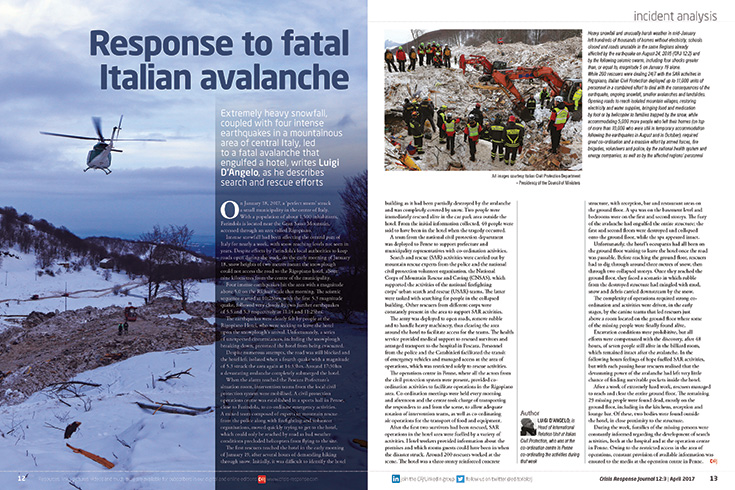
High-rise tragedy in Iran – As a firefighter there are few things worse and more moving than losing your fellow firefighters and colleagues while battling a blaze and rescuing people. Tragically, this happened in Iran earlier this year, when a blaze in a high-rise building left 16 firefighters and five civilians dead
London terrorist attack – Roger Gomm provides an overview of the terrorist attack on Westminster, London, outlining the importance of communities working together to protect the capital and to ensure preparedness
Warning and informing: Tweeting pressures – Terror incidents and hostile events are accompanied by a unique set of pressures and variables. Media departments should be regarded as an indispensible part of the authorities’ response strategy to terrorist incidents and hostile events, says Brian Dillon
Features
Stepping up online crisis response – Tim Lloyd says that, although some frontline emergency services have made great strides to harness the world of digital communication, a wide gap in preparedness for crisis communications still exists across a wide cross-section of government departments and agencies
Mine clearance in Iraq – Nigel Ellway, Head of Secretariat for the UK All Party Parliamentary Group on Explosive Weapons, provides CRJ with some observations from a recent visit to Mosul, Northern Iraq
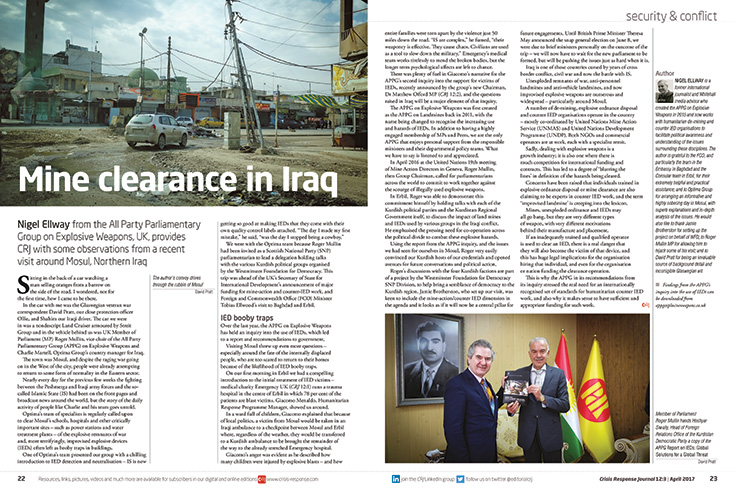
Psychosocial preparedness – Belinda Ekornas and Nils Petter Reinholdt describe the features of their work in psychosocial preparedness, including a new learning portal and lessons learnt from the interdisciplinary collaboration involved
Evolutions in terrorism: A tactical medic’s perspective – Emily Hough speaks to Dr Matthieu Langlois, a medic with France’s elite national counter-terrorist tactical unit, about his recently published book that traces the 2015 terrorist events in Paris
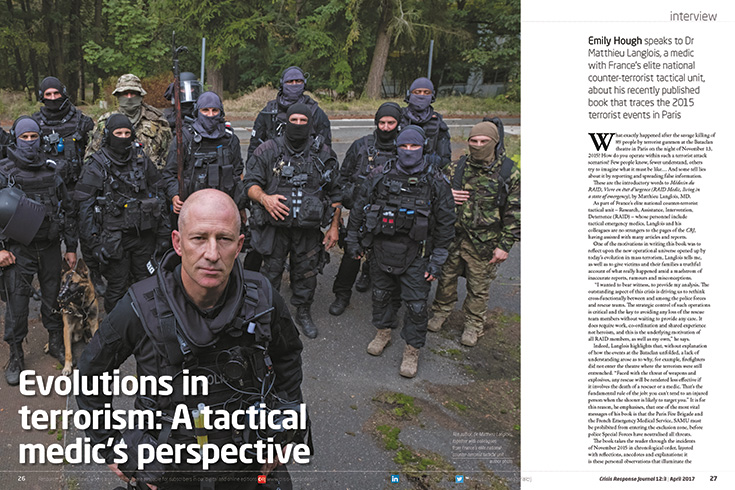
Virtual reality for first responders – Laurence Marzell presents an immersive virtual and mixed reality platform that trains personnel to respond to physical threats and cyber attacks on critical infrastructure and crowded places
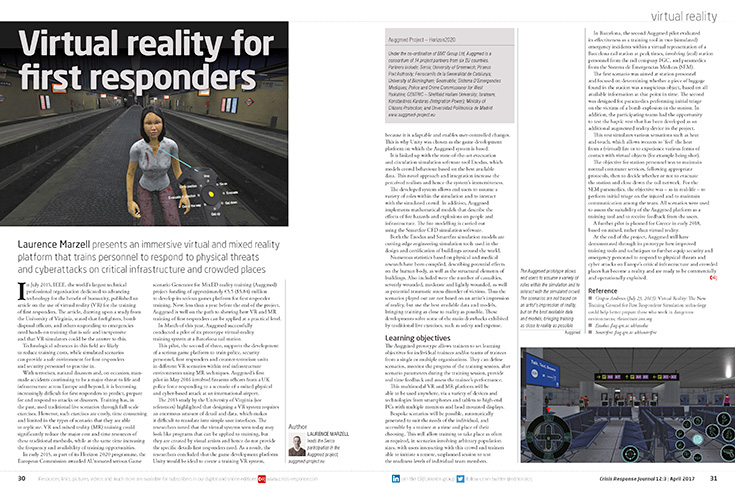
Gamifying cyber security training – Training police officers how to handle digital devices when dealing with cybercrime is crucial, but can be time consuming and expensive. Here, the developers of a prototype that aims to transform training in this area by harnessing serious games technology, outline a possible solution
CBRN strategy in Austria – In these times of heightened security tensions, especially in Europe, planning to manage the consequences of a CBRN has become ever more vital, explains Christian Resch
The consequences of piracy – Piracy, which decreased significantly around 2012, has once again been making the news this year, says Christoph Schroth. What are the wider consequences of piracy and what is being done on an international level to protect this important transportation sector?
Climate change and security – Caitlin E Werrell and Francesco Femia highlight just how seriously the threat that climate change poses to national security communities is being taken, given that it acts as a threat multiplier within the geostrategic environment
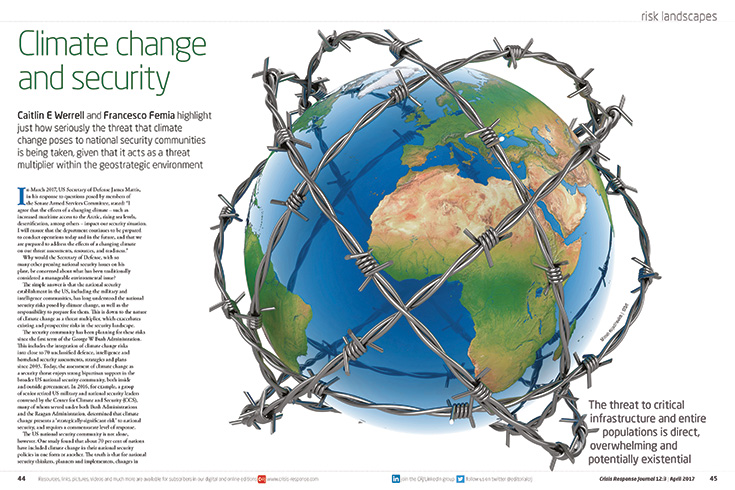
Global risks – Roger Gomm discusses the World Economic Forum’s Global Risks Report for 2017, which focuses attention on the evolution of global risks and the deep interconnections between them and finding that environment-related risks figure highly on the risk landscape
The challenging role of lawyers in crisis response – Companies – and their legal teams – need to understand that societal and community issues are as important as technical, legal, economic or engineering issues – these are vital to reputational management in a crisis, says Keith Ruddock
Natural partners in city resilience – A brand new, urbanised world requires a new approach to sustainability – insurers and cities must work more closely together, according to Butch Bucani and Evgenia Mitroliou
Beyond the classroom: Humanitarian field exercises – Students from the United Nations University Institute of Environmental and Human Security gained invaluable field experience during last year’s Triplex 2016 exercise, according to Joerg Szarzinski
Technological horizons
Space technology for crisis management – CRJ 10:4 introduced the Spartacus project, which developed robust satellite tracking solutions – backed up by smartphone and web apps – for use in emergencies. Here, Clemente Fuggini and Ivan Tesfai present the project’s achievements
Disaster metagenomics – The rapid detection of pathogens can reduce disease and mortality in the aftermath of terror events with unknown biological release, natural disasters and even in war zones. Matthew Rusling, Carly Esteves and Ian Portelli look at developments in disaster epidemiology
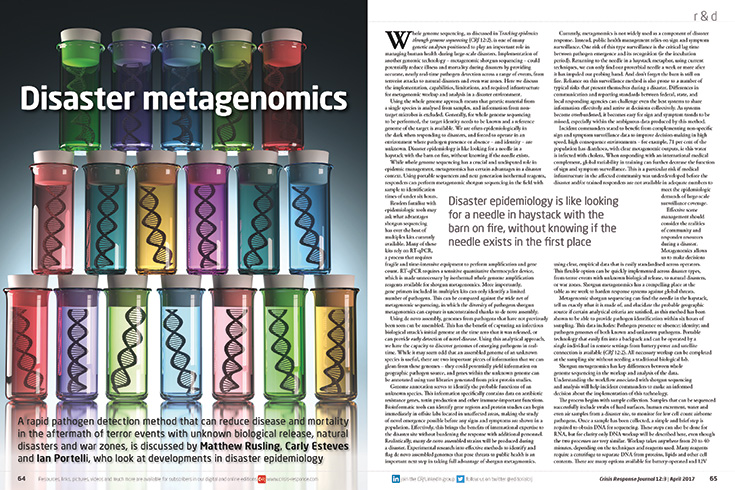
Virtual Reality in PTSD and beyond – Anna Roselle, Carly Esteves, Matthew Rusling and Ian Portelli describe how virtual reality is helping people who are suffering from PTSD, as well as how IBM’s Watson health programme is focussing on changing the way healthcare is accessed and utilised more generally
EENA and Waze join forces – When changing the world seems impossible, let’s try to change the small parts of it that we can, says Petros Kremonas and Alexis Gizikis, as they outline the strides that the European Emergency Number Association (EENA) has been making to enhance public safety

Small drones in search and rescue – Gemma Alcock and David Lane describe a newly-launched course for emergency service operators that provides familiarisation with the techniques for using UAVs and RPAS in search and rescue
In depth
Early warning systems in Caribbean islands – The Caribbean islands face repeated hazards on an annual basis, many of them weather-related, according to Marlon Clarke and Danielle Evanson, who say that early warning is the key as they discuss the opportunities and barriers to integrated early warning systems
Localising robotics for good – This issue, Andrew Shroeder describes how the Flying Labs – where local people work on how to apply drones for good in their country before a crisis hits – were set up and how the concept has developed
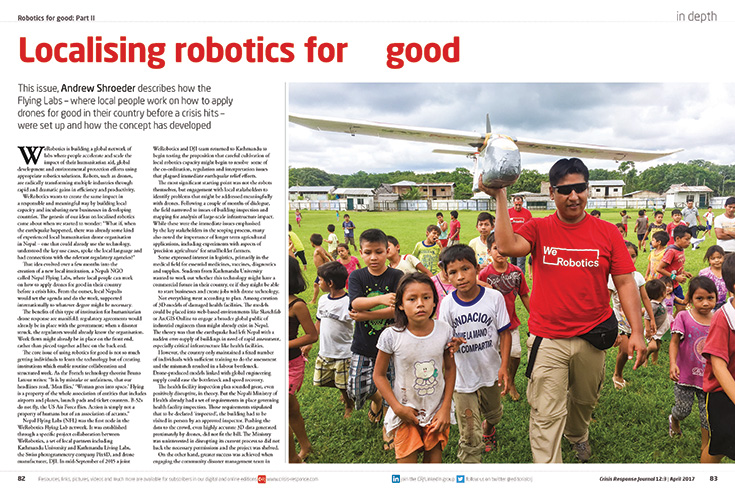
The nature of hypercomplex crises – In this final part of his series on developing incident command systems to deal with today’s hypercomplex crises, David Rubens sets the scene for how decentralised non-hierarchical response management systems can be developed

Simulating tunnel fires – In his third article, Christian Brauner introduces two Swiss tunnel training facilities in Balsthal and Lunger, and reflects on the current possibilities and limitations of simulating tunnel fire situations
Looking Back – Forty years ago the deadliest aircraft accident in the world happened when two aircraft collided at Los Rodeos Airport in Tenerife, resulting in the deaths of 583 people. Tony Moore provides an insight into this tragedy.
Frontline – Emily Hough speaks to Alaa Murabit, a Libyan-Canadian doctor and international advocate for the rights of women and young people, who says that we need to reintroduce compassion, care and empathy into global security and policy.